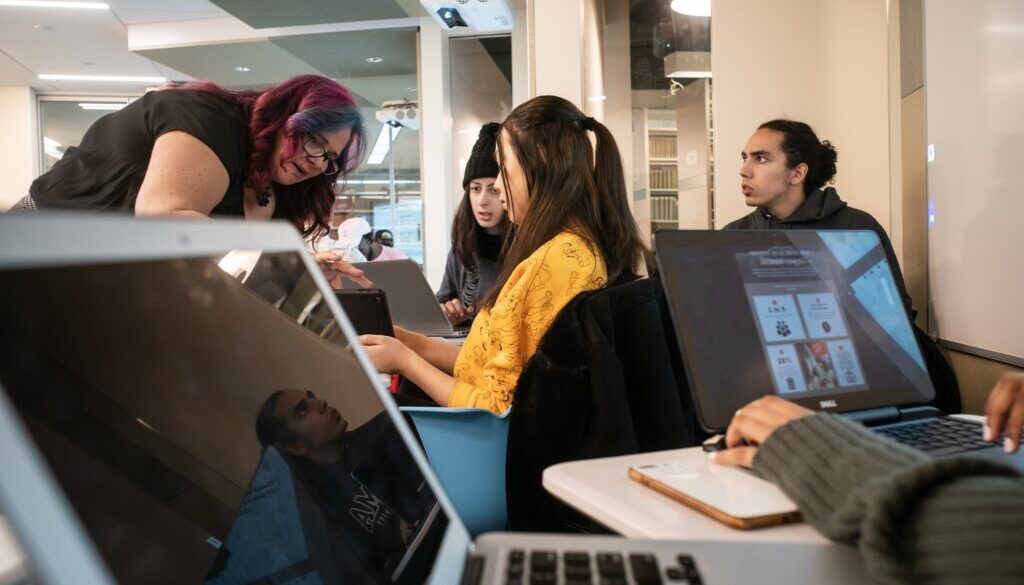Screens in the Classroom: Tool or Temptation?
By Michael T. LuongoOct. 24, 2019
This article is part of our continuing Fast Forward series, which examines technological, economic, social and cultural shifts that happen as businesses evolve.
Karen Huxtable-Jester, who teaches in the School of Behavioral and Brain Sciences at the University of Texas at Dallas, knows technology’s distractible downside. Once, while observing a lecture, Professor Huxtable-Jester discovered that a group of students had been watching a movie instead of their instructor.
“In years past, I was fully on board with the idea of banning technology use in my classes,” she said, making exceptions for students with disabilities who needed help. Over time, though, she became more flexible: “Every now and then, I could say, ‘Can we look something up?’”
The experience of Professor Huxtable-Jester, who is also the associate director at the university’s Center for Teaching and Learning, demonstrates evolving debates on whether smartphones, tablets and laptops divert students’ attention from the lesson at hand. “People develop very strong opinions,” she said. “The dividing line is everyone wants to do what is right, but no one knows what that is.”
Many professors and education professionals are discovering that rather than distract, strategically applied devices increase engagement with students, especially those with learning disabilities, who are on the autism spectrum and for whom English is a second language.
Brad Turner, vice president and general manager of global education and literacy for Benetech, a nonprofit educational software company that creates tools for students with dyslexia and other reading issues, said “technology is the great equalizer” that allowed “every student to learn in the way they need to learn or want to learn, to the greatest extent that they want to learn.”
That is the experience for Pamela Stemberg, an adjunct assistant professor of English at City College of New York who also teaches at Hostos Community College in the Bronx. “My students were the reason I started using technology because they were actually using it to look up things,” she said, including words they had never seen before. She likened this to its old-school analog experience: “Weren’t you told when you were a kid, ‘Go to the dictionary’?”
“Using technology in the classroom really enhances the whole class,” Professor Stemberg said.
Diverse backgrounds and varied exposure to the English language are part of why her students seek auxiliary help. Many are immigrants or American-born children of immigrants speaking another language at home. Even those from English-speaking countries do not always understand word nuances in poetry and literature. By using devices, Professor Stemberg said, students “are taking control of their learning; they become more engaged with it and they have more skin in the game.”
Guli Rahimova is a sophomore psychology major in Professor Stemberg’s Writing for the Sciences class at City College. Ms. Rahimova, whose family comes from Uzbekistan, said she and other students did not drift off when using devices in the classroom. “We are so focused on the group work trying to make it during the class time that we have together,” she said, “that we don’t have time to text and talk. We are really engaged in our work.”

On her own, Ms. Rahimova said, she had used her smartphone to look up words she did not understand, sometimes seeking out translations into Uzbek or Russian. “This helps me define it in English, to know this word,” she said.
Fatou Kanate, a native of Ivory Coast who is studying to be a radiology technician at Hostos Community College, found the smartphone useful in Professor Stemberg’s English 111 class. Ms. Kanate said that “while in the classroom working on group activities, we will look up words from literature.” She said that she and her classmates often found various definitions and that “we will decide together which is the context we are looking at.”
Such participatory methods make education “meaningful and authentic,” said Christine Greenhow, an associate professor of counseling, educational psychology, and special education at Michigan State University.
“When you ban technology, you close off access between the classroom and the world outside,” Professor Greenhow said. “And on the other hand, when you open up the classroom with technology, you are giving students the ability to connect to translation services, with databases to do research in real time, with other people they can connect with to get questions answered, because the instructor is only one person.”
Would students’ attention still wander if they had a device in their hand? Professor Greenhow acknowledged that it could still happen, but added that educators had a say in the matter.
“If you are finding your students are being distracted on their cellphones or on laptops, you have to ask yourself: What am I doing in my teaching that is not engaging?” she said. “How can I give them opportunities to participate so they don’t feel the need to disappear down the rabbit hole?”
She uses devices in the classroom to create a communication “back channel” with students, often integrated with social media. Students post questions on Twitter for journalists and authors, who respond in real time. Professor Greenhow said students “will find things in the news, in the media, tweet about it in the Twitter back channel, and I will end up projecting those tweets in class,” adding, “I have more insights into my students and what they want to learn more about.”
A study by David Baron, a researcher at the department of chemical engineering of the University of Cape Town in South Africa, and colleagues from the university, published in 2016 in the journal Computers & Education, defined the educational back channel as “software that allows a secondary, digital conversation to take place during a university lecture.” The study found that “a digital back channel increased the overall number of questions asked in a class,” with “little evidence of the back channel promoting distraction in class.”
Perry Samson, a professor in the University of Michigan’s department of climate and space sciences and engineering, developed his own back-channel program for his classes. “Students can click on that, and I’ve got a meter on the room, telling me how many students are confused.”
The app lets students give anonymous feedback answered in real time by teaching assistants as he lectures. Professor Samson also consults with the educational video technology platform company Echo360, which records, streams and captions live academic lectures, among other features. The company placed the back channel he developed into its Active Learning Platform.
These tools also help students who have special needs. Arianna Esposito, the director of life span services and supports for the advocacy group Autism Speaks, says students on the autism spectrum use smartphone-enabled augmented technology and other applications “at a much earlier age than ever before, and as those students age out, and enter college, they have developed new study skills and they have used cognitive behavioral support that helps them be successful in the classroom.”
While Ms. Esposito emphasized that a specific example cannot apply to everyone, useful and readily available smartphone, tablet and laptop features include notes to write out questions before speaking and calendar reminders. She also mentioned universities creating centers to help autistic students, including the Kinney Center at St. Joseph’s University in Philadelphia.
“By creating these inclusive classrooms, it has a much bigger impact,” Ms. Esposito said. “Not just for people with autism, but for people who are differently abled.”
Echoing this sentiment, Sean Smith, a University of Kansas professor of special education and a consultant with Understood, a nonprofit for people with learning issues, explained that “students with disabilities are definitely attending at a higher rate than in the past,” so universities need to make education accessible in real time. “This is the advantage of using smartphones in the classroom,” Dr. Smith said, mentioning that laws like the Americans with Disabilities Act require accommodations, which readily embedded smartphone technology can do.
Joseph Bavazzano, the director of Montclair State University’s ADP Center for Learning Technologies, works with college students who will become teachers.
His classes use smartphones for video projects and for FaceTime interviews with students from partner universities overseas. Mr. Bavazzano also runs what he calls “appy hour” discussions of new educational software. “If I am going to talk about an application that might potentially change the way your classroom is run,” he said, “I want to run my workshop that way so I want you to see the benefit and the value before we even get started.”
Far from discouraging devices, he said he often started lectures with this command: “Take out your phone and type in this URL, and let’s go.”


